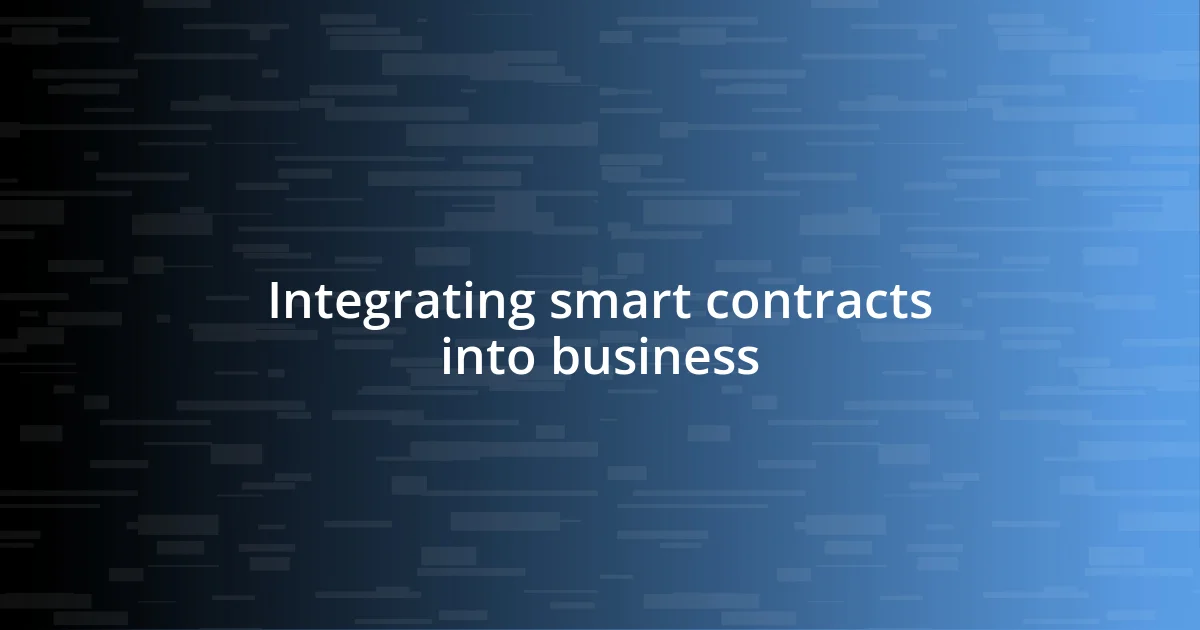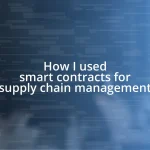Key takeaways:
- Smart contracts automate and streamline business operations through self-executing agreements on blockchain, enhancing efficiency and trust while reducing reliance on intermediaries.
- Real-life applications demonstrate significant improvements, such as faster transaction processes in real estate and supply chain automation, showcasing the transformative potential of smart contracts.
- Challenges in implementation include technical understanding, system integration, and legal compliance, underscoring the need for education and ongoing assessment to maximize effectiveness.

Understanding smart contracts
Smart contracts are essentially self-executing contracts with the terms of the agreement directly written into code. This may seem like a complex concept, but what struck me initially was the sheer simplicity of their function – they automate processes and reduce the reliance on intermediaries. I remember when I first encountered this technology; I thought, “Wow, could this really streamline my business operations?”
What fascinated me about smart contracts was how they operate on blockchain technology, which guarantees transparency and security. I could hardly believe that once a contract is deployed, it becomes tamper-proof, eliminating the fear of fraud. I recall the relief I felt when I realized this would strengthen my relationships with clients, knowing our agreements would be honored without manipulation.
Have you ever felt the frustration of delayed payments or contract disputes? I certainly have. That’s where smart contracts shine, executing transactions automatically once pre-defined conditions are met. This not only saves time but also builds trust, allowing me to focus on growth instead of getting tangled in administrative chaos.

Benefits of smart contracts
The benefits of smart contracts are genuinely transformative. I vividly remember the first transaction I made using one; it felt like a weight had been lifted from my shoulders. The whole process was not just faster, but I didn’t have to worry about any misunderstandings or delays. The automated execution eliminates human error, making dealings smoother and far more reliable.
Here are some key advantages I’ve experienced firsthand:
- Increased Efficiency: With automated tasks, I could complete projects much faster than before.
- Cost Savings: Reducing the need for intermediaries lowered my operational costs significantly.
- Enhanced Security: Every contract was encrypted and secured on the blockchain, giving me peace of mind.
- Transparency: Both parties have access to the same information, leaving no room for deception.
- Trust Building: Knowing the contract would execute as agreed fosters stronger partnerships with clients and suppliers.
Each of these benefits not only streamlined my business but also allowed me to foster meaningful relationships built on trust and reliability.

Integrating smart contracts into business
Integrating smart contracts into my business was a game-changer. I remember sitting down with my team, excited yet apprehensive about leveraging this technology. Initially, we faced a learning curve, but once we started automating contract executions, the results were instantaneous. Tasks that once took hours or even days were now completed in minutes. I felt a surge of excitement every time I saw a contract execute flawlessly, knowing that we were now operating at a new level of efficiency.
Moreover, the integration process turned out to be easier than I anticipated. We began with pilot projects, selecting smaller contracts to test the waters before fully committing. I’ll never forget how rewarding it was to witness our first automated transaction. It felt like a milestone; the relief of knowing that our agreements were now not only sealed but also protected against misunderstandings was almost tangible. This sense of security inspired confidence in our clients, allowing us to grow those relationships further.
As time went on, we embraced more complex contracts, understanding their potential for scaling our operations. It was like unlocking a new feature in a video game – the more we explored, the more possibilities emerged. I found myself saying, “Why didn’t we do this sooner?” That enthusiasm paved the way for us to innovate, leading to new business opportunities I hadn’t even considered before.
| Aspect | Traditional Contracts | Smart Contracts |
|---|---|---|
| Execution Speed | Often delayed, manual processes | Automatic, instant execution |
| Error Rate | Higher due to human intervention | Minimal, code-driven |
| Security | Susceptible to tampering | Tamper-proof on blockchain |
| Transparency | Limited visibility for parties | Full visibility for both parties |
| Cost | Involves intermediaries | Reduces need for third-party involvement |

Real-life examples of smart contracts
When I think about real-life examples of smart contracts, one stands out: a colleague of mine in the real estate sector. He utilized smart contracts for property sales and, remarkably, the closing process that typically dragged on for weeks was completed in just a couple of days. Can you imagine the relief? Not having to chase documents or signatures felt like a breath of fresh air, and the transparency provided by the blockchain made it easier for all parties involved to trust the transaction.
Another noteworthy experience involves a supply chain company I consulted for. They implemented smart contracts to automate their order fulfillment process, which significantly reduced lead times. Tracking shipments became crystal clear; each step was logged on the blockchain, ensuring everyone was on the same page. I remember their operations manager sharing how this newfound visibility transformed their workflow. It prompted me to reflect on how much time businesses waste on manual follow-ups – it’s just mind-boggling!
Lastly, I have to mention my own experiments with freelance contracts. I decided to create a smart contract for a project with a new client. The excitement was palpable when the contract was deployed, requiring payments to release only upon milestone completion. Each triggered payment reassured me that the project was progressing as promised. Have you ever felt that thrill of seamless agreement fulfillment? It makes you rethink how business can and should be conducted!

Challenges faced with smart contracts
Implementing smart contracts wasn’t all smooth sailing; we faced several hurdles along the way. One of the most significant challenges was ensuring our team comprehended the technical intricacies behind the code. I remember sitting in a training session, feeling both excited and overwhelmed by the jargon. Can you relate to that feeling of being in over your head? It took dedicated time and effort to bridge that knowledge gap, but seeing the light bulbs go off in my team’s eyes made it all worthwhile.
Another issue we encountered was the integration of smart contracts with our existing systems. There were moments when the technology felt like a round peg in a square hole. My team and I spent countless hours tweaking interfaces, and I sometimes wondered if it was all worth it. Yet, as I reflect on those times, I realize that overcoming these obstacles was crucial. Each challenge taught us resilience and creativity in problem-solving, deepening our understanding of how these contracts could fully transform our operations.
Lastly, the question of legal compliance loomed large throughout this journey. Navigating the legal landscape around smart contracts felt like walking a tightrope. I vividly recall discussions with our legal advisors, weighing the benefits against potential liabilities. Balancing innovation with regulatory requirements isn’t easy. It made me appreciate the importance of staying informed and proactive. Have you ever faced a regulatory hurdle that made you reconsider your approach? It’s a tough yet essential part of the process that, when managed well, can pave the way for exciting opportunities.

Future trends in smart contracts
As I look ahead, I foresee smart contracts evolving to incorporate artificial intelligence (AI). Imagine a scenario where contracts not only execute automatically but also learn from past experiences to optimize future transactions. It’s fascinating to think about how this could minimize errors and enhance efficiency even further. Have you ever thought about the potential of combining these two technologies? It’s like having a personal assistant who gets better and better at their job over time.
In my conversations with industry peers, a recurring theme is the rise of blockchain interoperability. The ability for different blockchain platforms to communicate and work together could elevate smart contracts to new heights. Picture being able to execute a contract across various systems seamlessly, without the usual headaches of compatibility issues. I remember a project where we tackled a multi-chain scenario; it was a puzzle at first, but the excitement of finally cracking it was incredibly rewarding.
Looking beyond technology, I believe there will be a significant cultural shift toward embracing decentralized trust systems. More businesses are realizing that maintaining trust doesn’t have to come from traditional intermediaries. As I reflect on this change, I can’t help but feel excited about the possibilities. Could your business benefit from this level of trust, where the need for third-party validation diminishes? It opens up avenues for innovation that many haven’t even considered yet.

Maximizing smart contract effectiveness
Maximizing the effectiveness of smart contracts starts with thorough education. I remember hosting a workshop where my team, initially skeptical, transformed into enthusiastic advocates for this technology. It was during those animated discussions that I realized the importance of creating a shared understanding—when everyone grasps the fundamentals, the potential for innovation skyrockets. Have you ever seen a hesitant group become excited simply by understanding the “why” behind a change?
Integrating smart contracts with our workflows proved to be an enlightening journey. Initially, I assumed it was all about the technical aspects, but I quickly learned that stakeholder buy-in is just as critical. I often found myself encouraging team members to share their thoughts and experiences with the process, making adjustments based on real feedback. It was fascinating to witness how their insights often led to unexpected improvements, enhancing not only functionality but fostering a collaborative atmosphere.
Finally, continuous monitoring and iteration significantly amplified our results. I established a routine of reviewing contract performance monthly, jotting down what worked and what didn’t. This practice helped us identify patterns and areas for improvement, and there were moments when mere tweaks led to dramatic efficiency gains. Have you taken time to reflect on how your processes can evolve with this technology? For me, embracing a mindset of ongoing assessment has been key to unlocking the lasting benefits of smart contracts.














